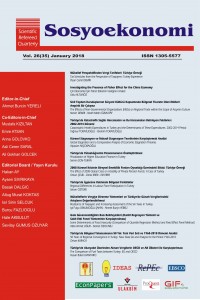Öz
Bu çalışmanın temel amacı Türkiye’de işgücüne katılım oranlarında bölgesel dinamiklerin analiz edilmesidir. Çalışma kapsamında TÜİK’ten elde edilen bölgesel istatistikler kullanılarak işgücüne katılımın temel belirleyenleri sistem GMM modeli kullanılarak tahmin edilmiştir. Söz konusu tahmin, hem farklı bölgeler hem de farklı bölge tanımları dikkate alınarak bölgesel kukla değişkenler yardımıyla sağlamlık sınamalarına tabi tutulmuştur. Çalışmadan elde edilen bulgular, işgücüne katılımın bölgeler arasında farklı dinamik süreçlerinin olduğuna yönelik hipotezi desteklemektedir. Bu nedenle, işgücüne katılım oranlarını artırmaya yönelik politikalar bölge/zaman boyutlarından farklı düşünülmemelidir.
Anahtar Kelimeler
Kaynakça
- Aaronson, S., Cajner, T., Fallick, B., Galbis-Reig, F., Smith, C., & Wascher, W. (2014). Labor force participation: recent developments and future prospects. Brookings Papers on Economic Activity, 2014(2), 197-275. Arellano, M., & Bond, S. (1991). Some tests of specification for panel data: Monte Carlo evidence and an application to employment equations. The review of economic studies, 58(2), 277-297. Arellano, M., & Bover, O. (1995). Another look at the instrumental variable estimation of error-components models. Journal of econometrics, 68(1), 29-51. Benito, A., & Bunn, P. (2011). Understanding labour force participation in the United Kingdom. Blundell, R., & Bond, S. (1998). Initial conditions and moment restrictions in dynamic panel data models. Journal of econometrics, 87(1), 115-143. Ersungur, Ş. M. (2016). Bölgesel İktisat Teori, Politika ve Uygulama. İmaj Yayınevi. Fujita, S. (2014). On the causes of declines in the labor force participation rate. Research Rap Special Report, Federal Reserve Bank of Philadelphia, 6. Grabowski, R., Self, S., & Shields, M. P. (2007). Economic development: a regional, institutional, and historical approach. ME Sharpe. Haughton, G., & Counsell, D. (2004). Regions and sustainable development: regional planning matters. The Geographical Journal, 170(2), 135-145. Henderson, V. (2002). Urbanization in developing countries. The World Bank Research Observer, 17(1), 89-112. Kepenek, Y., & Yentürk, N. (2005). Türkiye Ekonomisi, 10. Baskı, Remzi Kitabevi, İstanbul. Kılıç, D., & Öztürk, S. (2014). Türkiye’de Kadınların İşgücüne Katılımı Önündeki Engeller ve Çözüm Yolları: Bir Ampirik Uygulama. Amme İdaresi Dergisi, 47(1), 107-130. Krugman, P. R. (1991). Geography and trade. MIT press. Krugman, P., & Venables, A. J. (1995). Globalization and the Inequality of Nations. The quarterly journal of economics, 110(4), 857-880. Litzinger, P. J., & Dunn, J. H. (2015). The Labor Force Participation Rate: A Rexamination Of The Determinants Of Its Decline. Journal of Applied Business Research, 31(6), 2283. Nonaka, I., Toyama, R., & Konno, N. (2000). SECI, Ba and leadership: a unified model of dynamic knowledge creation. Long range planning, 33(1), 5-34. Pike, A., Rodríguez-Pose, A., & Tomaney, J. (2006). Local and Regional Development. Routledge. Stimson, R. J., Stough, R. R., & Roberts, B. H. (2006). Regional economic development: analysis and planning strategy. Springer Science & Business Media. UNDP. (2016). Human Development Report 2016 Human Development for Everyone. Lowe-Martin Group.
Öz
Main purpose of this study is to analyse the regional dynamics in labour force participation rates in Turkey. The main determinants of labour force participation is analysed via dynamic system GMM methodology, using regional statistics from Turkish Statistical Institute. The estimation results are checked for robustness using different definitions of regions and with the aid of regional dummies. The findings of the study support the working hypothesis of this study and reveals different dynamic processes for regions. Therefore, policies aiming to increase labour force participation rates should acknowledge region/time specific dimensions.
Anahtar Kelimeler
Labour Force Participation Regional Development Dynamic Panel Data GMM
Kaynakça
- Aaronson, S., Cajner, T., Fallick, B., Galbis-Reig, F., Smith, C., & Wascher, W. (2014). Labor force participation: recent developments and future prospects. Brookings Papers on Economic Activity, 2014(2), 197-275. Arellano, M., & Bond, S. (1991). Some tests of specification for panel data: Monte Carlo evidence and an application to employment equations. The review of economic studies, 58(2), 277-297. Arellano, M., & Bover, O. (1995). Another look at the instrumental variable estimation of error-components models. Journal of econometrics, 68(1), 29-51. Benito, A., & Bunn, P. (2011). Understanding labour force participation in the United Kingdom. Blundell, R., & Bond, S. (1998). Initial conditions and moment restrictions in dynamic panel data models. Journal of econometrics, 87(1), 115-143. Ersungur, Ş. M. (2016). Bölgesel İktisat Teori, Politika ve Uygulama. İmaj Yayınevi. Fujita, S. (2014). On the causes of declines in the labor force participation rate. Research Rap Special Report, Federal Reserve Bank of Philadelphia, 6. Grabowski, R., Self, S., & Shields, M. P. (2007). Economic development: a regional, institutional, and historical approach. ME Sharpe. Haughton, G., & Counsell, D. (2004). Regions and sustainable development: regional planning matters. The Geographical Journal, 170(2), 135-145. Henderson, V. (2002). Urbanization in developing countries. The World Bank Research Observer, 17(1), 89-112. Kepenek, Y., & Yentürk, N. (2005). Türkiye Ekonomisi, 10. Baskı, Remzi Kitabevi, İstanbul. Kılıç, D., & Öztürk, S. (2014). Türkiye’de Kadınların İşgücüne Katılımı Önündeki Engeller ve Çözüm Yolları: Bir Ampirik Uygulama. Amme İdaresi Dergisi, 47(1), 107-130. Krugman, P. R. (1991). Geography and trade. MIT press. Krugman, P., & Venables, A. J. (1995). Globalization and the Inequality of Nations. The quarterly journal of economics, 110(4), 857-880. Litzinger, P. J., & Dunn, J. H. (2015). The Labor Force Participation Rate: A Rexamination Of The Determinants Of Its Decline. Journal of Applied Business Research, 31(6), 2283. Nonaka, I., Toyama, R., & Konno, N. (2000). SECI, Ba and leadership: a unified model of dynamic knowledge creation. Long range planning, 33(1), 5-34. Pike, A., Rodríguez-Pose, A., & Tomaney, J. (2006). Local and Regional Development. Routledge. Stimson, R. J., Stough, R. R., & Roberts, B. H. (2006). Regional economic development: analysis and planning strategy. Springer Science & Business Media. UNDP. (2016). Human Development Report 2016 Human Development for Everyone. Lowe-Martin Group.
Ayrıntılar
| Bölüm | Makaleler |
|---|---|
| Yazarlar | |
| Yayımlanma Tarihi | 31 Ocak 2018 |
| Gönderilme Tarihi | 15 Mayıs 2017 |
| Yayımlandığı Sayı | Yıl 2018 Cilt: 26 Sayı: 35 |


